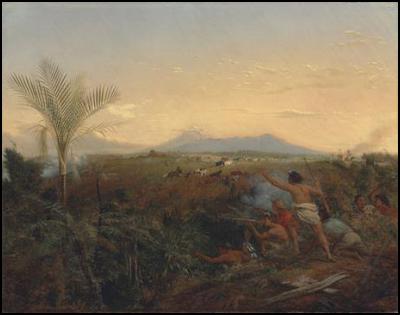Te Papa brings colonial masterpiece home to New Zealand
Te Papa brings colonial masterpiece home to New Zealand
A rare and historically significant painting set in Taranaki during New Zealand’s land wars will go on display to the public in its new home at Te Papa next week.
The oil painting, View of Mt Egmont, Taranaki, New Zealand, taken from New Plymouth, with Maoris driving off settlers’ cattle, was made over 150 years ago in 1861 by English artist, William Strutt.
It depicts an imagined scene based on newspaper reports of the Taranaki wars and sketches Strutt made during his brief residence in New Zealand from 1855 to 1856.
Te Papa was offered first right to buy the painting due to its historical importance to New Zealand, and purchased it for approximately $1.5 million from a family who have owned it since the 1860s.
“This acquisition is a major investment, in a very important piece of work. There are very few paintings that reflect the historical events that were unfolding during this period - it captures a powerful moment in our history,” says Te Papa Chief Executive Rick Ellis
“I expect this dramatic painting will become an icon of the national collection, and we’re delighted New Zealanders will now have the opportunity to see it.”
The work is one of seven known oil paintings Strutt completed based on New Zealand subjects, and is the first to enter a public art gallery in New Zealand. It will complement the collection of drawings and works by Strutt currently held by the Alexander Turnbull Library.

“It’s fantastic that this painting is now coming home to Aotearoa New Zealand,” says Te Papa’s Kaihautū Arapata Hakiwai.
“The period represents a significant part of the nation’s shared history, and historical work like this plays an important role when we look back and reflect on our identity today.”
Te Papa’s Historical New Zealand Art Curator, Dr Rebecca Rice says the new painting will strengthen the national art collection.
“It’s rare to have a painting that allows reference to the disputes between Māori and Pākehā in the 1850s and 60s. Typically painters of that era focussed on New Zealand’s unoccupied and pristine landscape to encourage immigration, or made portrait studies of Māori.”
“Strutt combines these in one painting to create an exotic spectacle. On the plains in front of majestic Mt Taranaki, Māori are driving settlers’ cattle off disputed land, supported by the armed group concealed by scrub in the foreground. Smoke from settlers’ rifles is visible on the left of the painting while a homestead is burning on the right.” says Dr Rice.
“The national art collection doesn’t have any other significant oil paintings from 1850s and 1860s, so this painting is particularly precious.”
The 640 x 840mm oil painting, which is in remarkably good condition for its age, will require some conservation treatment. But before that happens, visitors will have the opportunity to see it on display as part of the new Ngā Toi | Arts Te Papa season, opening on 6 November.
ENDS


 NZ Amateur Sport Association: 22 Amendments Proposed For 2022 Act Lodged On 22 November
NZ Amateur Sport Association: 22 Amendments Proposed For 2022 Act Lodged On 22 November Auckland University of Technology: Reading Helps Children Face A Difficult Future
Auckland University of Technology: Reading Helps Children Face A Difficult Future PATHA: Puberty Blocker Evidence Brief Affirms Aotearoa’s Approach
PATHA: Puberty Blocker Evidence Brief Affirms Aotearoa’s Approach Tataki Auckland Unlimited: Into Ocean & Ice - Unveiling Antarctica's Past And Present
Tataki Auckland Unlimited: Into Ocean & Ice - Unveiling Antarctica's Past And Present Health Coalition Aotearoa: Urgent Action Needed To Address Aotearoa’s Shameful Household Food Insecurity
Health Coalition Aotearoa: Urgent Action Needed To Address Aotearoa’s Shameful Household Food Insecurity GPNZ: 2023/24 New Zealand Health Survey - One Quarter Of Kiwi Adults Unable To Access General Practice
GPNZ: 2023/24 New Zealand Health Survey - One Quarter Of Kiwi Adults Unable To Access General Practice